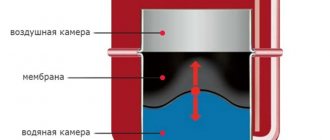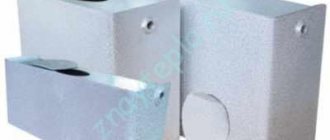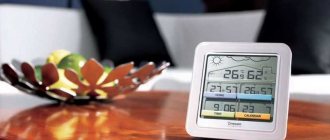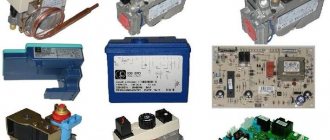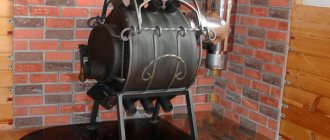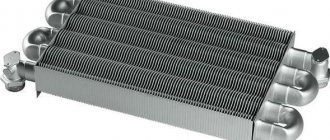Ceramic heater device
The design of such heating systems includes ceramic heaters in the form of a plate, with the help of which the room is heated. The body of the device itself is filled with a special glaze that protects the device from moisture and also prevents corrosion. Converter models have an additional built-in miniature fan.
Infrared ceramic heaters are designed a little differently. Depending on the model, the device may be equipped with wire, spiral or cable, which provide high resistance, but are also resistant to sudden temperature changes. As for the wave range, it is average. Such equipment is considered to be a “dark” emitter, that is, it does not glow at night. The emitters themselves are divided into the following forms:
- spherical;
- flat;
- ceramic;
- infrared.
It is worth noting that all ceramic home heaters are fireproof. In addition, during operation they consume a minimal amount of electricity and allow you to save on utility bills.
Ceramics have long been used by people in construction and everyday life. This popularity is due to the material’s ability to retain heat for a long time. A surface heated to a certain temperature emits heat rays. Their wavelength is determined by the interval from 9.0 to 10.3 microns. Objects located within this radius heat up, creating a comfortable microclimate in the room.
When heated, ceramics have a fairly wide range of radiation distributionInitially, the design of the heating device was developed on the basis of a plate with ceramic elements placed on it. A fan directed at the heated ceramics forcibly sets in motion a warm flow throughout the room. This solution prevents the air from drying out. The heating process itself occurs gradually without sudden changes in temperature.
Modern models are reliably protected from overheating and falling. They do not burn oxygen or dry out the air. The presence of several heating elements allows you to adjust the power if necessary. Main structural components:
- metal case;
- profiled heat exchanger;
- main heating element;
- ceramic plate.
Special air filters clean the air masses, which prevents dust particles from igniting on the ceramic coating. All heaters of this type are equipped with temperature sensors and microclimate regulators.
The operating principle of a ceramic heating device is similar to the effect of natural solar thermal radiation. Under the influence of a fan, heat waves are distributed throughout the room, heating the walls, floor and other furnishings.
Advantages and disadvantages
Despite the fact that the manufacturer blatantly deceives its customers, there is something good in this heater. Therefore, we highlight several advantages:
- heats up quickly enough and maintains a stable temperature;
- power consumption corresponds to reality;
- the design of the ceramic heater does not contain elements that can overheat, this is a serious advantage and a plus for karma;
- can be installed in the bathroom. This is where we recommend installing them, since their consumption is often small, but they cope with their tasks perfectly;
- easy to install;
- works without noise. But, after a while, in any case, extraneous sounds begin, there is no escape from them, since the case is constantly heating up or cooling down, and this provokes its deformation.
Related article: Building a bathhouse with your own hands (step by step)
Minuses:
- The manufacturer blatantly deceives its customers by promising unrealistic savings and productivity. Don't look at this - it's a blatant deception for which you need to be judged.
- Many models are not equipped with thermostats. Therefore, you have to buy additional thermostats yourself or constantly turn it on and off depending on the heating of the room.
- Price. The cost of ceramic heaters is clearly not justified, even though they have a beautiful appearance. For that kind of money you can buy an excellent Noiro convector, which is famous for its quality and high efficiency.
Operating principle of ceramic heaters
Such heating equipment operates on the principle of forced convection. All heating elements in the device are blown with an air mass, due to which warm currents are evenly distributed throughout the room.
Some modern electric heaters operate from a remote control, are equipped with a timer and a number of other useful functions. In addition, they are able to purify the air and ionize it.
Infrared devices are capable of emitting thermal energy only in a certain direction. Despite this, heat penetrates into room furniture and flooring, so we can say that such heaters never run idle.
Working principle of ceramic heating element
The heater has ceramic plates that are blown with hot air, causing them to warm up slowly. After the plates of the heating element warm up, they accumulate heat for a long time and even after turning off the device they will still give off heat for some time and actively warm the room. This is a big advantage compared to other types of heaters.
The principle of operation does not involve oxygen intake, since the heater has a fan that supplies air to the plates. As a result, the air in the room does not dry out, and heating is carried out gradually.
Roughly speaking, a ceramic heater is like a fan that blows hot air through ceramic plates. Thanks to this scheme, not just warm, but hot air is introduced into the room, which, for example, heat fans cannot do.
Advantages and disadvantages of ceramic heaters
Even the most advanced design has its advantages and disadvantages. Ceramic heaters were no exception. Along with undeniable advantages, the devices have a number of significant disadvantages.
pros
The most significant advantages of ceramic heaters include:
- Ceramics is a material of natural origin. At an operating temperature of 800–1000°C, substances harmful to the human body are not released. Alternative options, if used incorrectly, can cause harm to health (dry skin, pathologies of the lens, etc.).
- High efficiency rate (within 90-99%). Such data is considered normal for most devices operating from the mains.
- During operation, the working elements are not subject to oxidation, which increases the service life of the heating device. Metal heat exchangers fail faster due to corrosion processes.
- Equipping the structure with a fan helps to quickly and evenly heat the room. The effect is comparable to thermal fans, but in other respects the latter are significantly inferior.
- Due to its physical properties, ceramics retain heat for a long time. This helps reduce energy consumption (gas or electricity), unlike other devices equipped with heating elements or coils. Heating with infrared devices is also not cheap.
- The compact parameters of ceramic heaters and low weight make it possible to use the heating device in small rooms without taking up useful space. Even in a small room there is room to install a wall model. Infrared devices and radiators running on oil cannot boast such an advantage.
- Modern models of ceramic appliances are protected from fires and burns. The front panel does not heat up above 65°. In heat fans, the spiral is open; as dust and other contaminants accumulate, the risk of self-ignition increases. The surfaces of oil coolers become so hot that they can cause burns.
- Some models are equipped with a lamp that cleans surfaces and air from harmful microorganisms. The product range has been replenished with devices with built-in ionization, which is important for people with weakened bodies.
- The heater operates absolutely silently.
- The laconic design of the case and compactness fit harmoniously into the design of any style.
- Some models are equipped with a remote control. This makes it possible to change the heating mode without getting up from the sofa or chair.
Types of ceramic heaters
Electric devices are the easiest to use and safe, so they can be installed even in a child’s room. At the same time, during operation they do not dry the air or burn it, which is why they are often used in rooms where high humidity prevails.
Fan heaters are more complex equipment. The principle of operation is that the working fan draws in a cold air stream, processes it and releases it already warm. The advantages of such devices are their compactness; they can equip even the smallest rooms, and if necessary, the device can be easily transported to another place.
Glass-ceramic heaters also differ in design features. They are:
- filled;
- hollow.
The first models are very durable, they have a high degree of protection against oxidation and various types of contamination. Another feature of such designs is smooth temperature control. They are quite easy to use and install; anyone can install the device, even those without experience. The entire process is usually described in the instructions.
Hollow models heat up very quickly, but also cool down just as quickly.
In addition, all heating installations differ in the method of placement:
- Wall-mounted ceramic heaters are quite large, so most often they are mounted at the bottom of the wall. They are excellent for furnishing rooms with a medium area, have a long service life, last about 25 years, and are able to accumulate heat. Fastened using self-tapping screws, anchors and dowels.
- Floor-standing units are additionally equipped with a safety system, so in the event of a fall they turn off automatically, which prevents breakdowns or any emergency situations. Perhaps these are the most convenient devices of all presented, suitable for any type of room. Very easy to install: just screw the legs to the body and choose a flat surface.
- Tabletop appliances have a rotating ability, due to which warm air is evenly distributed in all directions of the room. The device itself will fit perfectly into a small room, as it is small in size. Any surface in the form of a table, bedside table or window sill is suitable for installation.
There is another type of heater that is suitable for heating very small rooms, small offices and studies. This type of device has an original appearance. The design consists of three ceramic pots, held together by an elongated metal bolt onto which washers and nuts are screwed. These pots have incandescent lamps built into them.
Such devices are good because during operation they do not emit combustion products, which means they are safe for others. They can be used as an additional heat source.
A significant disadvantage of such creative devices is the long heating process: the device must first warm up itself, and only then it will begin to heat the surrounding space. This usually takes 3-4 hours.
Electrical devices
These are the most common heating devices that are quickly and easily installed in rooms for various purposes. Models of this type have a certain power, which allows you to choose the most suitable option.
How to choose a ceramic heater for an apartment and other rooms
Before purchasing a heating device, you need to decide on the model. Experts recommend considering the following factors when choosing a suitable heater:
- The area of the heated room. The power of the equipment is responsible for this (1 kW can heat approximately 10 square meters).
- External data of the heating unit. It is better to select devices that will not spoil the design of the room.
- Equipped with an electric thermostat. This is important in order to maintain a constant temperature.
- Room dimensions. For small rooms it is better to purchase wall-mounted heaters.
- Availability of built-in protective grille. This will make the operating process safer.
In fact, many owners of ceramic heaters believe that the price of such installations is unreasonably high, since in winter these devices cannot fully heat the room. And if in an apartment they can still be useful, then for heating a large private house these structures are absolutely useless.
Why does a heater need a panel design?
The panel is very convenient for placement in any room. A ceramic heater for the home can be made as a ceiling-mounted, wall-mounted, or portable one . Ceramic heating devices had limitations. The thermal expansion of nichrome wire differs from that of ceramics. Therefore, it inside the ceramic panel could break off when the temperature rises.
Instructions for modifying a ceramic heater with your own hands
Do-it-yourself integration of electronic automation into a ceramic heater / Thermoregulator W1209
Ceramic heater
The purchased ceramic heater had three operating modes - fan, heater mode 1 and heater mode 2. The instructions strictly state that when you turn off the heating mode, you must leave the fan on for some time until the massive heating element cools down. This posed the main obstacle to quickly finalizing the heater’s operation scheme. If this condition is not met, there is a serious risk of damaging the plastic case over time. But there are no insurmountable obstacles, especially since life in 2021 has forced us to save on everything; in short, we managed to start the heater in safe mode with our own hands.
Disassembling a ceramic heater
This heater has a reasonable design and to access the main electrics, you just need to unscrew the 4 screws securing the leg cover with your own hands. We unscrew them and gain access to the display board. The heater circuit is simple. Look at the photo. Indication circuits are connected in the power supply circuit of the fan and two heaters. The operation indicator has been carefully removed as unnecessary. Only two decorative red LEDs were left, which had never lit before; it turned out that the polarity of their activation was reversed. After dismantling the display board, gaps appeared in the power wires of the fan and heaters along the neutral wire, which will be used to connect to the control circuits.

